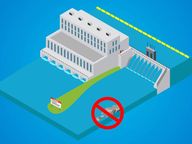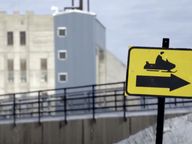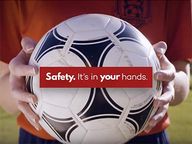Signs can save your life
The signs around our equipment can save your life. Watch to learn how to be safe around our equipment.
How signage can save your life
It’s important to obey signs around Manitoba Hydro equipment — they can save your life. Watch to learn how to be safe around our equipment.
Limits of approach around overhead electrical lines
Limits of approach is how far away people or equipment must stay from overhead electrical lines to make sure a work site is safe. For work that is planned near overhead electrical lines, consult the Manitoba Workplace Safety and Health Act and Regulation (Part 25, page 227 “Work in the vicinity of overhead electrical lines”) for direction on people or equipment near our limits of approach.
Distance from overhead electrical lines for people and equipment
If your project needs workers or equipment to come close to the minimal distances listed below, you must contact us at 1-888-624-9376 (1-888-MBHYDRO) before you start your project.
| Operating voltage of overhead electrical line | Safe limit of approach distance for people and equipment |
|---|---|
| 0 volts to 75,000 volts | 3.0 metres |
| 75,000 volts to 300,000 volts | 4.5 metres |
| More than 300,000 volts | 6.0 metres |
| DC ground electrode | 3.0 metres |
If the voltage is unknown, keep people and equipment at least 3 metres away from the overhead lines on any single pole structures and 4.5 meters from any double pole structures. If people or equipment are working near our steel tower lines, people and equipment should maintain at least 6 metres of separation from the overhead lines.
Estimate distances
If you think you are too close, do not use a measuring tape or any other object to check your distance; you could be electrocuted.
Snowmobiles & all-terrain vehicles
Avoid driving near substations, power lines, and hydroelectric facilities on or off the trail. Darkness, fog, and blowing snow can make hazards difficult to spot and avoid.
Keep watch for:
- Guy wires with bright yellow covers at bottom.
- Downed poles and power lines.
- Waterways near hydroelectric dams and generating stations.
If someone does make contact with a downed power line, either directly or through their snowmobile or all-terrain vehicle (ATV), do not touch them or any objects around them. Call 911 or your local emergency services immediately.
Snowmobile Safety
Here are some things you should do to stay safe on the trails.
Dams and generating stations
Water around our generating stations is turbulent. Strong currents, undertow, and rapidly changing water levels can quickly turn a dry riverbed into fast-moving water.
- Stay a safe distance away from marked-off areas when fishing, boating, or swimming. Getting too close or ignoring warning signs can be fatal.
- In winter, never snowmobile, walk, snowshoe, cross-country ski, skate, or ice fish on waterways near dams and generating stations. The ice can be dangerously thin and unstable even if it appears solid.
Manitoba Hydro facility safety
Manitoba Hydro’s infrastructure provides safe and reliable energy, but there are dangers associated with fast flowing water and high-voltage electricity. Watch this video to learn how to ensure your safety around our infrastructure.
Stay safe around dams

Stay away from booms in waterways.
Enlarge image: Safety booms mark dangerous water zones near spillway entrances.
These rules apply whether you are upstream or downstream from a hydro dam:
- Look for and obey all warning signs.
- Stay on clearly-marked walkways or observation points.
- Stay away from fenced-off areas such as:
- booms (temporary floating barriers) or buoys (anchored floats) in waterways;
- other barriers that prevent access to dangerous places.
- Listen for a generating station warning horn or siren — it means the water levels are changing so move away quickly if you are downstream.
Avoid dangerous waterway zones
Choose a generating station from the map below to see where the zones are marked. From mid-May to mid-October, the danger zone near the spillway entrance is marked by a boom (temporary floating barrier).
If the problem continues, you may need to disable your ad blockers to view the map.
This map is for general information only. It should not be used for navigation or to determine distance, direction, or hazard locations.
Padmount transformers
A padmount transformer reduces the voltage of electricity that flows to your home. This large green metal box means there are buried electrical lines in the area.
- Before digging, click before you dig to locate underground lines.
- Do not block the padlock side of the padmount transformer with shrubs or structures as we must be able to reach it for maintenance.
- Ensure children do not use a padmount transformer as a play structure. The transformers are locked for safety and signs on the box warn of electrical danger.
People who break into a transformer can receive severe injuries or a fatal shock. If you see a padmount transformer that has been damaged or vandalized, stay clear, and call us any time at 1-888-624-9376 (1-888-MBHYDRO).
Green metal boxes
Some neighbourhoods have green or grey metal boxes around. Some of these boxes belong to us, some belong to telecommunications companies, and some are joint-use. If one of these boxes is damaged, it could pose a safety risk. Our boxes have dangerous high-voltage electricity in them. If you see a broken one, please call us right away.
Our boxes should have:
- a brass or red lock holding it shut;
- bolts to help keep it shut;
- a Manitoba Hydro “DANGER” sticker;
- a serial/equipment number.
Substations
Substations are part of our electrical distribution system. The high voltage electricity inside a substation can cause severe injuries or death.
Security fencing around the substation protects people and animals from high voltage contact. Vandals who open gates or cut holes in the fence can make it easier for children and animals to enter.
If you see suspicious activity around a substation, or a damaged or vandalized fence, call us any time at 1-888-624-9376 (1-888-MBHYDRO).
Play it safe around substations
Valour FC reminds kids to stay away from our high-voltage equipment.
Flight safety around power lines
Overhead power lines and structures can pose a safety risk for pilots involved in low level flying. Whether you’re involved in aerial spraying, or recreational flying, plan ahead to stay safe.
Before you fly
- Identify where power lines or structures may pose a hazard along your flight path. Discuss power line locations with property owners.
- Be aware that not all wires can be easily seen. Skywires run along the very top of transmission lines and can be especially hard to see.
- Consider rescheduling your work if the forecast calls for bad weather. Poor weather conditions and flying at dawn or dusk can reduce the visibility of power lines.
- Take precautions to reduce the risk of damage to our equipment and power lines. You or the company you fly for are financially liable for the cost of Manitoba Hydro’s repairs.
If your aircraft contacts a power line
- Ensure your safety.
Do not touch downed power lines or anything in contact with them. Touching fallen wires and these objects can have serious or fatal results. - Immediately cut off the fuel supply if it is safe to do so.
Electrical accidents are complicated by the presence of fuel and potential for fire. - Assume downed wires are live even if they are not sparking.
Report any contact with power lines or structures immediately to 911 or your local emergency services.
Visit the Transport Canada website for recommended practices on flying near power lines.
Safe excavation around underground electric and natural gas facilities
Underground electric cables and natural gas piping can pose a safety risk if you want to excavate. From road reconstruction and water/sewer renewals, to fence building or tree planting, any excavation greater than 15 cm requires a Manitoba Hydro representative to issue an Electric and/or Natural Gas Facilities Locate form prior to excavating.
Right-of-way
Landowners grant us ROW, which is a strip of land that contains our facilities. This allows us access for the purpose of inspection, maintenance, testing, or emergencies. A ROW also identifies an area that restricts certain activities such as digging and blasting.
Minell Pipeline
The Minell pipeline is a transmission pressure natural gas pipeline and is federally regulated by the Canada Energy Regulator (CER). This federally regulated pipeline starts near Moosomin, SK, travels 4 km to the Saskatchewan–Manitoba border, and continues up to Russell, Manitoba. The Minell Pipeline has a 30-metre prescribed area outside of the right-of-way (ROW) that restricts some activities.
You must get our consent before you start any construction or excavation work on or around the Minell pipeline (for example, installing field drainage, stump removal).
For consent for a construction or excavation project, email us.
Download safety guidelines
- Safe Excavation and Safety Watch Guidelines (PDF, 1.2 MB)
International power lines
International power lines are under the jurisdiction of the Canadian Energy Regulator.




